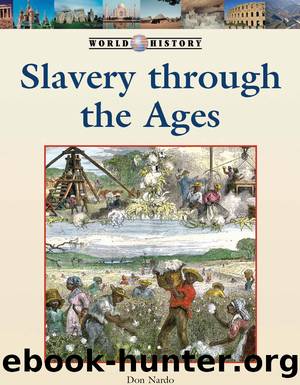Slavery Through Ages by Nardo Don;

Author:Nardo, Don;
Language: eng
Format: epub
Publisher: Greenhaven Publishing LLC
the serfdom of the Middle Ages. Some of these men may already have been deeply in debt to the landowner before they arrived on his estate. From that time onwards . . . they had to [give the owner] a huge proportion of the crops they were allowed to produce on his land, or sometimes served directly as part of his labor force. In return, they hoped to be able to rely on their new landlords to chase the governmentâs tax collectors away.37
The wealthy landlords who employed these quasi-serfs were extremely successful, so much so that they survived Romeâs political collapse. They went on to become some of the earliest medieval lords, with their manor houses, extensive fields and orchards, and large numbers of serfs to maintain them. It made no sense to enslave these workers. After all, if the landowners did that, they would have to feed and clothe them, whereas free serfs were expected to feed and clothe themselves. Hence, serfdom made more economic sense in that situation.
The Trans-Saharan Slave Network
As long as that particular situation remained the norm, the need for slaves remained nearly nonexistent in medieval Europe. However, outside of Europe during this period, slavery was still alive and well. Several of the societies that flourished along Europeâs borders, especially those of the Arabs and other Muslims in the Middle East and North Africa, maintained small but profitable traditional slavery systems.
Most of the slaves exploited in these lands were obtained from sub-Saharan Africa. This came about in part because Islamic law states that Muslims cannot enslave one other. To find slaves, therefore, Muslim merchants and slave catchers had to go to foreign lands, and they were pleased to find a plentiful source of black Africans dwelling not far south of the vast Sahara Desertâs arid reaches.
After capturing a group of Africans, the traders sold them to home and farm owners in the Middle East and North Africa, where many of the newly enslaved individuals toiled as field hands, domestics, and mine laborers. Other black slaves were coerced into converting to Islam and served in Muslim armies. There, over time, because of their intelligence and courage, they were entrusted with a great deal of responsibility and military authority. Bamber Gascoigne points out one surprising outcome of this trend:
Download
This site does not store any files on its server. We only index and link to content provided by other sites. Please contact the content providers to delete copyright contents if any and email us, we'll remove relevant links or contents immediately.
Percy Jackson and the Olympians: The Chalice of the Gods by Riordan Rick(1177)
Closer by Gordon Roderick & Williams Brian(1024)
Take a Closer Look at Your Eyes by Janet Slike(972)
Harry Potter and the Order of the Phoenix: SparkNotes Literature Guide by SparkNotes(915)
Common Core Math For Parents For Dummies with Videos Online by Christopher Danielson(800)
Good Clean Jokes to Drive Your Parents Crazy by Bob Phillips(785)
When Parents Aren't Around by Jamie Clubb(773)
GQ GQ. Where Are You? by Sharon Ritt(769)
Everything You Need to Ace Math in One Big Fat Notebook by Altair Peterson(727)
Piece of Cake! by Dana Meachen Rau(671)
Mrs. dalloway by Virginia Woolf(552)
Love Potion #8 (Avatar: The Last Airbender) by Nickelodeon Publishing(528)
The Twistrose Key by [email protected](464)
The 39 Clues - Rapid Fire: Invasion by Riley Clifford(455)
Illuminations by T. Kingfisher(444)
Warriors_The Broken Code 3_Veil of Shadows by Erin Hunter(439)
The Fog of War by Michelle Jabes Corpora(438)
A Forest Divided by Erin Hunter & Wayne McLoughlin(424)
The Last of the Sages: The Complete Bastion Trilogy by Julius St. Clair(418)
